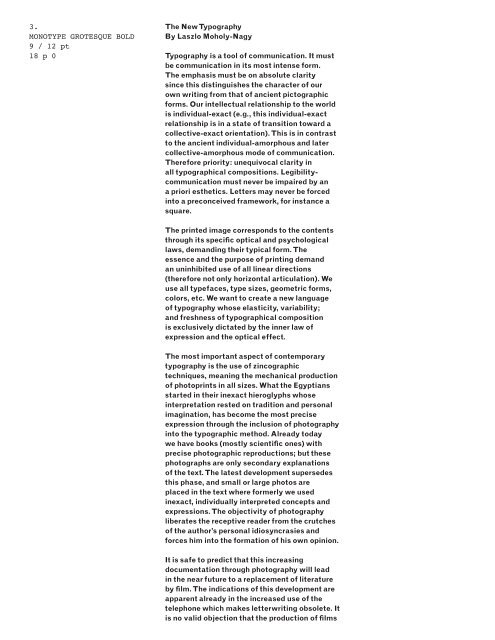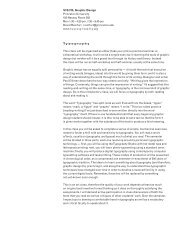Download the PDF here. - typography
Download the PDF here. - typography
Download the PDF here. - typography
You also want an ePaper? Increase the reach of your titles
YUMPU automatically turns print PDFs into web optimized ePapers that Google loves.
3.<br />
MONOTYPE GROTESQUE BOLD<br />
9 / 12 pt<br />
18 p 0<br />
The New Typography<br />
By Laszlo Moholy-Nagy<br />
Typography is a tool of communication. It must<br />
be communication in its most intense form.<br />
The emphasis must be on absolute clarity<br />
since this distinguishes <strong>the</strong> character of our<br />
own writing from that of ancient pictographic<br />
forms. Our intellectual relationship to <strong>the</strong> world<br />
is individual-exact (e.g., this individual-exact<br />
relationship is in a state of transition toward a<br />
collective-exact orientation). This is in contrast<br />
to <strong>the</strong> ancient individual-amorphous and later<br />
collective-amorphous mode of communication.<br />
T<strong>here</strong>fore priority: unequivocal clarity in<br />
all typographical compositions. Legibilitycommunication<br />
must never be impaired by an<br />
a priori es<strong>the</strong>tics. Letters may never be forced<br />
into a preconceived framework, for instance a<br />
square.<br />
The printed image corresponds to <strong>the</strong> contents<br />
through its specific optical and psychological<br />
laws, demanding <strong>the</strong>ir typical form. The<br />
essence and <strong>the</strong> purpose of printing demand<br />
an uninhibited use of all linear directions<br />
(<strong>the</strong>refore not only horizontal articulation). We<br />
use all typefaces, type sizes, geometric forms,<br />
colors, etc. We want to create a new language<br />
of <strong>typography</strong> whose elasticity, variability;<br />
and freshness of typographical composition<br />
is exclusively dictated by <strong>the</strong> inner law of<br />
expression and <strong>the</strong> optical effect.<br />
The most important aspect of contemporary<br />
<strong>typography</strong> is <strong>the</strong> use of zincographic<br />
techniques, meaning <strong>the</strong> mechanical production<br />
of photoprints in all sizes. What <strong>the</strong> Egyptians<br />
started in <strong>the</strong>ir inexact hieroglyphs whose<br />
interpretation rested on tradition and personal<br />
imagination, has become <strong>the</strong> most precise<br />
expression through <strong>the</strong> inclusion of photography<br />
into <strong>the</strong> typographic method. Already today<br />
we have books (mostly scientific ones) with<br />
precise photographic reproductions; but <strong>the</strong>se<br />
photographs are only secondary explanations<br />
of <strong>the</strong> text. The latest development supersedes<br />
this phase, and small or large photos are<br />
placed in <strong>the</strong> text w<strong>here</strong> formerly we used<br />
inexact, individually interpreted concepts and<br />
expressions. The objectivity of photography<br />
liberates <strong>the</strong> receptive reader from <strong>the</strong> crutches<br />
of <strong>the</strong> author’s personal idiosyncrasies and<br />
forces him into <strong>the</strong> formation of his own opinion.<br />
It is safe to predict that this increasing<br />
documentation through photography will lead<br />
in <strong>the</strong> near future to a replacement of literature<br />
by film. The indications of this development are<br />
apparent already in <strong>the</strong> increased use of <strong>the</strong><br />
telephone which makes letterwriting obsolete. It<br />
is no valid objection that <strong>the</strong> production of films




